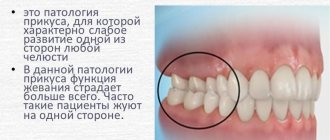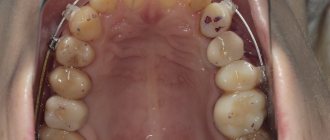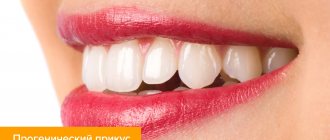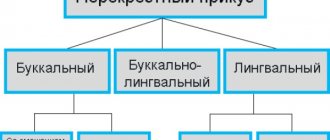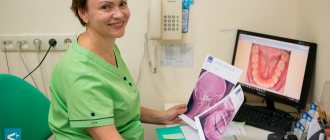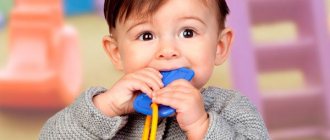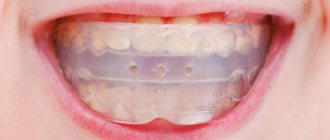What is orthodontics?
A young area in veterinary practice, but steadily developing and in demand. A veterinary orthodontist (dentist) corrects existing dental anomalies or prevents possible ones by monitoring the dog from puppyhood. Our veterinary clinic has created a dental department, which contains all the options for specific devices (braces) for correcting bites in dogs of different ages, breeds and sizes.
It is important to understand! The sooner the dog owner brings his pet for a consultation with a dentist (orthodontist), the higher the likelihood of correcting the bite correctly and achieving the desired results in a short time. In older animals, the jaw bones become denser and remodeling occurs much more slowly.
Clinical orthodontic cases
Rostral deviation (rostroversion) of the upper canine
Malaligned canine syndrome is a malocclusion in which a retained primary tooth misaligns an erupting permanent canine tooth into an abnormal position. Opposing canines may not have room to occlude properly, leading to abnormal wear, periodontal disease, or early tooth loss
Left - This device pulls the tooth back to give the lower canine a proper bite. To avoid complications, regular examinations are recommended. This device must be cleaned after each feeding. Right - After correction, the fang fell into place.
Anterior crossbite
| Left - Young dog, ten months old. Anterior crossbite. In the center - The orthodontic structure will guide the lower incisors back. On the right is the result of treatment. |
Pomeranian Spitz snack
The Pomeranian Spitz dog had a snack. During orthodontic treatment, a device was used to move the upper incisors forward.
Left - before correction. On the right, after correction, the bite became scissor-shaped.
Bite correction: which age is best?
Puppies are born toothless! The incisors appear first, by about a month, followed by the canines and the last premolars (5-6 weeks). There are fewer “children’s” teeth, only 28; after changing permanent teeth at 4-6 months, there are 42. They are larger, the enamel is yellower and stronger.
The following are considered abnormal in quantity:
- oligodontia (incomplete set of permanent teeth);
- polio- or hyperdontia.
The last two concepts refer to the presence of extra teeth. According to the norm, by 7 months the dog’s teeth should completely change and premolars and molars, for which there are no milk predecessors, should grow.
Etiological factors and responsibility
Breeders do not always realize that when purchasing a puppy with malocclusion, they take on additional responsibility for the maintenance and treatment of such a pet. Crooked teeth injure the gums, tongue, cheeks, and lips of dogs. Such animals are discarded and are not bred! This is explained by a genetically inherited pathology - malocclusion is passed on to puppies from their parents, so they are not allowed at exhibitions.
As etiological factors (reasons), specialists of the RosVet VC consider:
- heredity;
- improper games or training. The breeder tugs too hard on a toy, rope or stick, practically ripping it out of the mouth or encouraging the puppy to hang on it;
- irrational, unbalanced diet, causing a lack of calcium, fluoride, etc.;
- discrepancy between the number and size of teeth and jaw;
- traumatization;
- delayed change of teeth or eruption of permanent teeth when milk teeth have not fallen out.
The latter is false polyodontia, which is often diagnosed in toy terriers. The reason for this is the poor development of the chewing muscles, insufficient resorption of the roots of baby teeth and errors in nutrition, when owners give soft food with a low calcium content.
Causes of malocclusions
The most common cause of malocclusion, unfortunately, cannot be eliminated. This is a hereditary factor. The only way to prevent its spread to offspring is to deprive genetically inferior animals of permission to breed.
In addition, this pathology can also be acquired. It is most often caused by insufficient care of the puppy. There are several such factors:
- Repeated heavy loads on the teeth of a young animal during active games of tug are very unhelpful for him. You need to carefully control the force with which the puppy pulls the coveted toy.
- The consequences of trauma and damage to the jaws when chewing bones and hard objects often lead to malocclusion.
- Violation of the timing of the loss of milk teeth leads to the fact that the growing molars, bumping into the missing milk teeth, change their direction of growth.
- Lack of calcium, vitamin D, and an unbalanced diet lead to rickets and gradually deform the bite.
- Abnormally short labial frenulums cause the teeth to be compressed, causing the bite to become pathological.
Malocclusion: description of defects
A veterinary orthodontist at the RosVet VC describes the following types of malocclusion in dogs, which are often encountered in practice. This:
- prognathia (underbite), in other words, a visually shortened lower jaw, its poor development, when the lower incisors do not reach the upper ones. When the mouth is closed, a significant gap is formed between the upper and lower incisors. Normally this should not happen! Such dogs are discarded at the exhibition and are not allowed for breeding;
- progenia (overbite) or excessive protrusion of the lower jaw forward, and the lower incisors protrude above the upper ones. Normally, a reverse scissor bite occurs in Shih Tzus, bulldogs, and boxers.
“Direct bite” is the most uncomfortable, the upper and lower incisors touch each other, the teeth grind down faster and incorrectly.
There is an acquired malocclusion - “anterior crossbite”, when several lower incisors protrude above the upper ones, but the remaining teeth are normal. It is formed if the owner often plays tug of war with the puppy.
A crooked bite is a genetically inherited severe defect when one part of the jaw grows faster than the opposite. In this case, the lower canines tilt inward and damage the palate. Often the same defect occurs with false polyodontia or with a very narrow jaw.
Open bite - the incisors are spaced vertically and stand without touching each other. A distinctive feature is the tongue hanging outward, and after a detailed examination (X-ray), impacted teeth remaining in the jaw are discovered.
Is it necessary to “take out” unerupted teeth from the thickness of the jaw? Yes, if they put pressure on neighboring ones, promoting their migration and resorption, they cause pain. If deep-lying teeth do not cause problems for the dog, eating and chewing food is normal - they are left in place, periodically observing them.
Correct bite. Snack. Underbite.
Bite in dogs is the relationship between the dentition of the upper and lower jaw. The type of bite in a dog is determined by the nature of the closure of the dentition and can be of four types: scissor-shaped (“scissors”), straight (“pincers”), overshot, undershot. The bites listed above depend on the length and position of the jaws. In addition, the bite can change for various reasons, and be, for example, floating (a temporary phenomenon in puppies due to a soft, undeveloped jaw), skewed (improper tooth growth, trauma, congenital anomalies) or alveolar (improper inclination of the teeth) .
Chinese crested bite
The normal bite of a Chinese Crested dog is described by the standard as a scissor bite (or, as dog lovers call it, “scissors”). With this type of bite, the upper canines slightly cover the lower ones. In this case, the lower canines should enter the interdental space between the upper extreme incisor and the upper canine, but the surfaces of the teeth should not touch.
CORRECT BITE
DIRECT BITE
Straight bite in an adult dog
CHILDREN'S UNDERBITE
The bite should be formed by the age of 45-50 days (about 1.5 months) - at the time of activation of the puppy. Sometimes, however, there are puppies whose lower jaw seems to be slightly pushed back. This is the so-called “children’s underbite” or it is also called “deep bite”.
The reason for puppy underbite can be explained very simply - baby teeth are very small and take up relatively little space on the jaw. The gap that remains between the jaws, and which is so similar to an underbite, is free space for larger molars. As you grow, after changing teeth, this deficiency is corrected without any intervention.
Children's underbite, which will improve with age
UNDERBITE
Underbite is a pronounced gap between the incisors of the upper and lower jaw. Underbite is an unacceptable form of bite for the Chinese Crested. Such dogs should be excluded from breeding activities and sold without the right to participate in exhibitions and breeding.
A very severe underbite can cause the fangs of the lower jaw to injure the gums of the upper jaw. In this case, it is recommended to remove the lower canines and the dog can lead a normal life. Underbite no longer affects the dog's health in any way.
Since we are talking about underbite, dogs also have another form of overbite - compensated underbite. Compensated underbite is characterized by some shortening of the lower jaw in combination with an alveolar inclination of the incisors and canines. Thus, the lower jaw is significantly shorter than the upper jaw, but the incisors and canines on the lower jaw are located at such an angle that they come into contact with the upper teeth and form a tight scissor bite.
SNACK
An underbite is a form of bite in which the incisors of the lower jaw are located in front of the incisors of the upper jaw (the so-called “bulldog” or “bulldog jaw”). Overbiting is an unacceptable form of overbite for a Chinese Crested. Such dogs should be excluded from breeding activities and sold without the right to participate in exhibitions and breeding.
A very pronounced undershot can be noticeable when looking at the dog’s face - the lower jaw protrudes, the tongue or fang sticks out. In this case, you can remove the protruding teeth, or contact a veterinary dentist.
Very often, a puppy’s malocclusion can form when the owner allows the change of baby teeth to molars to happen. Due to impaired tooth growth, the puppy’s teeth change process incorrectly and an incorrect bite is formed. For example, a primary canine does not allow the molar to grow properly, which causes the molar to move the incisors. Read the article - Changing baby teeth in a puppy.
How malocclusion in dogs is corrected at the RosVet Exhibition Center
The specialists at the RosVet veterinary clinic have in their arsenal the most modern types of devices that are used to correct bites. Conventionally, they are divided into braces, or fixed and removable structures.
"The squeak of fashion"
Invisible braces are most in demand among dog owners; they are the rage in veterinary orthodontics. They are transparent, removable mouthguards that are made from an impression of the dog’s jaw. A special advantage is the ability to remove them while eating or for cleaning/sterilization.
Acrylic invisible trays, adjacent to the teeth, put pressure on them, “forcing” them to grow in the desired direction. Once every 1-2 weeks they are replaced with new ones made to different sizes. This technology allows you to straighten your bite due to the fact that the teeth gradually correct their position.
The advantage of such mouthguards is that they are unobtrusive; the dog does not wear them all the time, but for several hours a day. But in veterinary practice they are little used due to the high cost of this technology for correcting the bite.
Braces for dogs
Braces, or staples, are complex devices made of wires and “clasps” that are secured to the teeth. Fastened at a certain angle and having different thicknesses of wire, braces exert varied pressure on crooked teeth, which are gradually returned to their normal position. The thicker the wire, the stronger the pressing force.
Owner actions
A responsible owner must understand that a corrected bite in a pet does not mean that no matter how good its exterior is, this representative can participate in breeding. A female or male will definitely pass this defect on to her offspring.
After getting braces, your dog needs to brush his teeth daily to prevent food from accumulating under the steel mechanism, irritating his gums. The mandatory cleaning ritual takes little time, the animal quickly gets used to it and the teeth remain healthy .
a special collar on him . The collar is not removed until the dog stops paying attention to the braces.
What should a dog owner with an overbite know?
The use of braces on dogs requires constant supervision by the breeder. It is necessary to properly care for structures, prevent mechanical damage, and clean them. You need to play carefully with a dog that has braces; do not give bones or very hard food, as the braces may break.
You cannot install braces if you have stomatitis, allergy to alloy, periodontitis, ulcerative stomatitis and neoplasms in the oral cavity.
A positive prognosis for correcting malocclusion depends on an adequate diagnosis and the choice of the optimal treatment method. And this is only possible in a modern veterinary clinic with a fully equipped dental office - such as in the RosVet VC!
If your dog has an incorrect bite, has problems with grasping and chewing food, or the pet does not look aesthetically pleasing due to dental problems - do not hesitate! Call the RosVet VC by phone, 24 hours a day, and make an appointment for your dog with an orthodontist.
Main types of bite
There are several types of bite patterns in dogs. They depend on the breed of the animal. Main varieties:
- scissor-shaped - is normal,
- pincer-shaped - the second name for straight,
- undershot,
- snacking is more common in bulldog-shaped dogs.
Depending on the dog's breed, the structure of the jaws, their length and development may vary.
However, sometimes a distortion in the structure of the facial bones is possible. Attention! A dog's bite is also affected by teeth - they can grow incorrectly, which is why various pathologies arise.

